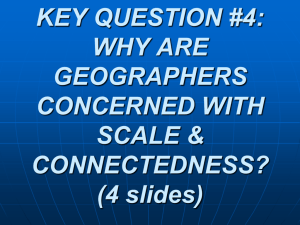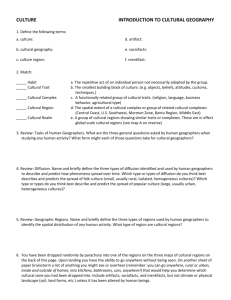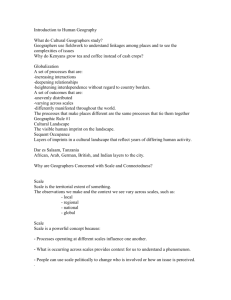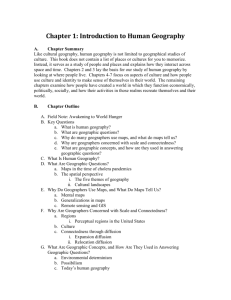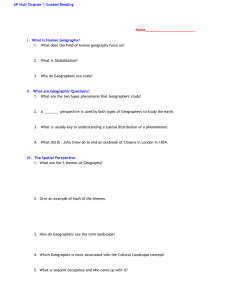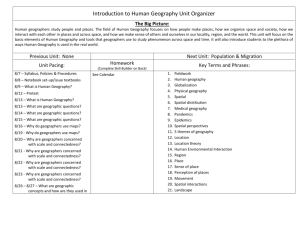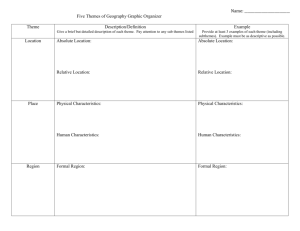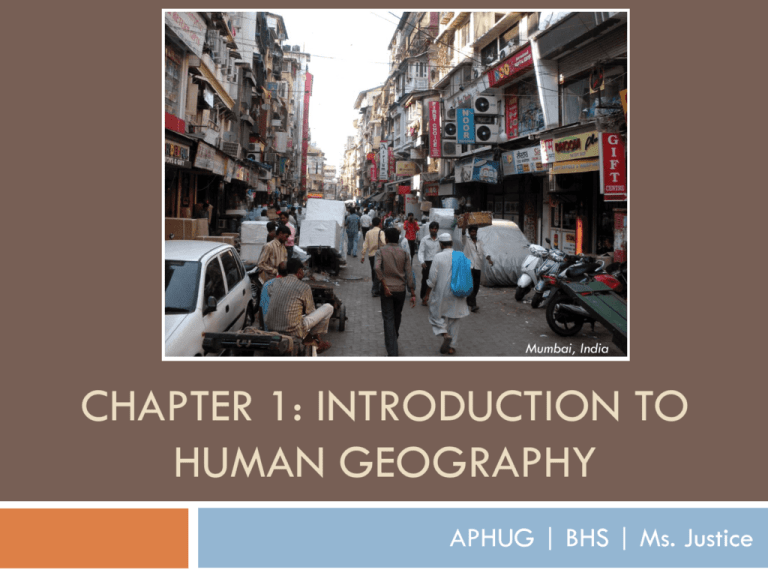
Mumbai, India
CHAPTER 1: INTRODUCTION TO
HUMAN GEOGRAPHY
APHUG | BHS | Ms. Justice
Key Question 1.4
Why are geographers concerned with
scale and connectedness?
© 2012 John Wiley & Sons, Inc. All rights reserved.
Why Are Geographers Concerned with Scale
and Connectedness?
Scale has two meanings in
geography:
1. The distance on a map
compared to the
distance on the Earth
2. The spatial extent of
something
Why Are Geographers Concerned with Scale
and Connectedness?
Geographers’ interest in the scale involving the
spatial extent of something derives from the
fact that phenomena found at one scale are
usually influenced by what is happening at
other scales.
The scale of our research matters because we
can make different observations at different
scales.
© 2012 John Wiley & Sons, Inc. All rights reserved.
Why Are Geographers Concerned with Scale
and Connectedness?
The scale at which we study a geographic
phenomenon tells us what level of detail we can
expect to see.
Geographers’ concern with scale goes beyond
an interest in the scale of individual phenomena
to how processes operating at different scales
influence one another.
© 2012 John Wiley & Sons, Inc. All rights reserved.
Global Scale
Regional Scale
Local Scale
Why Are Geographers Concerned with Scale
and Connectedness?
Regions
• A formal region has a
shared cultural or physical
trait. Example: Frenchspeaking region of Europe
• In geography, a region
constitutes an area that
shares similar
characteristics.
© Barbara Weightman
Why Are Geographers Concerned with Scale
and Connectedness?
A functional region is defined by a particular
set of activities or interactions that occur within
it. Ex: the City of Chicago
Perceptual regions are intellectual constructs
designed to help us understand the nature and
distribution of phenomena in human geography.
© 2012 John Wiley & Sons, Inc. All rights reserved.
Where is The South?
Why Are Geographers Concerned with Scale
and Connectedness?
Perceptual Regions in the United States
• Cultural geographer Wilbur Zelinsky identified 12 major
perceptual regions
on a series of maps
in “North America’s
Concept Caching: Paris,
Vernacular Regions.”
France
Guest Field Note
Montgomery, Alabama
“Located in a predominately
African American neighborhood
in Montgomery, Alabama, the
street intersection of Jeff Davis
and Rosa Parks is symbolic of the
debates and disputes in the
American South over how the
past is to be commemorated on
the region’s landscape. The Civil
War and civil rights movement
are the two most important
events in the history of the
region.”
Why Are Geographers Concerned with Scale
and Connectedness?
Culture
Culture is an all-encompassing term that
identifies not only the whole tangible lifestyle
of peoples but also their prevailing values and
beliefs.
It is closely identified with the discipline of
anthropology.
Cultural geographers identify a single attribute
of a culture as a culture trait.
60 Second Reflection
In your notes, provide 2 specific examples of
cultural traits
(the kinds of clothes worn by a group of people
wear, food, economics, architecture, language,
ethnicity, religion, arts, politics, education, etc.)
Why Are Geographers Concerned with Scale
and Connectedness?
Culture
Culture complex: More than one culture
may exhibit a particular culture trait, but
each consists of a discrete combination of
traits. Ex: varieties of Santa/Christmas
celebrations around the world
A cultural hearth is an area where cultural
traits develop and from which cultural traits
diffuse. Ex: Saudi Arabia is the cultural
hearth of Islam
Why Are Geographers Concerned with Scale
and Connectedness?
Connectedness through Diffusion
Expansion diffusion: when an
innovation or idea develops in a
hearth and remains strong there
while also spreading outward.
Ex: Islam
Contagious diffusion: a form of
expansion diffusion in which nearly
all adjacent individuals and places
are affected. Ex: Silly Bandz
Why Are Geographers Concerned with Scale
and Connectedness?
Hierarchical diffusion is a pattern in
which the main channel of diffusion is
some segment of those who are
susceptible to (or adopting) what is
being diffused. Ex: Crocs footwear.
Stimulus diffusion: Not all ideas can be
readily and directly adopted by a
receiving population; yet, these ideas
can still have an impact. Ex: burgers in
India
Why Are Geographers Concerned with Scale
and Connectedness?
Relocation Diffusion
Occurs most frequently through migration
Involves the actual movement of individuals who
have already adopted the idea or innovation,
and who carry it to a new, perhaps distant,
locale, where they proceed to
disseminate it
60 Second Reflection
In your notes, create a chart or graphic organizer
that includes the different types of diffusion and
an example of each (preferably an example that
isn’t already in your notes/textbook)
Once you think about different types of diffusion, you will
be tempted to figure out what kinds of diffusion are
taking place for all sorts of goods, ideas, or diseases.
Please remember that any good, idea, or disease can
diffuse in more than one way. Choose a good, idea, or
disease as an example and describe how it diffused from
its hearth across the globe, referring to at least three
different types of diffusion.
© 2012 John Wiley & Sons, Inc. All rights reserved.

